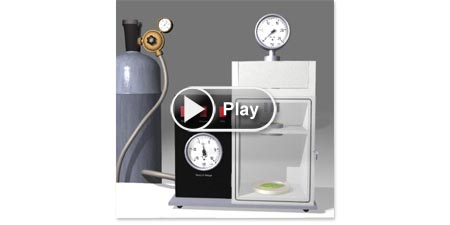
Principle of plant transformation by bombardment
Step 1 - Coating of particles with DNA
This approach uses metal particles, coated with foreign DNA, that are projected at high speed onto plant cells. For this purpose, minute gold or tungsten particles are first coated with DNA.
Step 1 - Coating of particles with DNA
This approach uses metal particles, coated with foreign DNA, that are projected at high speed onto plant cells. For this purpose, minute gold or tungsten particles are first coated with DNA.
Principle of plant transformation by bombardment
Step 2 - Loading particles on disk
DNA coated particles are loosely attached onto a plastic disk.
Step 2 - Loading particles on disk
DNA coated particles are loosely attached onto a plastic disk.
Principle of plant transformation by bombardment
Step 3 - The particle gun
The plastic disc, with the DNA particles, is put in the particle gun. This disc is called the flying disc, as it will be projected at high velocity. The rest of the particle gun consists of a rupture disc (in yellow at the tip of the particle gun) that separate a high pressure gas chamber, and a stopping screen (the grid at the bottom of the particle gun) that will stop the flying disc when shot.
Step 3 - The particle gun
The plastic disc, with the DNA particles, is put in the particle gun. This disc is called the flying disc, as it will be projected at high velocity. The rest of the particle gun consists of a rupture disc (in yellow at the tip of the particle gun) that separate a high pressure gas chamber, and a stopping screen (the grid at the bottom of the particle gun) that will stop the flying disc when shot.
Principle of plant transformation by bombardment
Step 4 - Shooting
The gas chamber is filled with inert gas (helium or nitrogen). At a determined pressure the rupture disc brakes releasing the gas that projects the flying disc against the stopping screen. While stopped, the DNA coated particles are released from the flying disc and projected into the plant material below.
Step 4 - Shooting
The gas chamber is filled with inert gas (helium or nitrogen). At a determined pressure the rupture disc brakes releasing the gas that projects the flying disc against the stopping screen. While stopped, the DNA coated particles are released from the flying disc and projected into the plant material below.
Principle of plant transformation by bombardment
Step 5 - Transformation
In the cell, particles can release their DNA coating. The DNA molecules can then reach the nucleus and become integrated.
Because of the damage it can cause to cells, particle bombardment leads to low survival rate. Different solutions have been developed to increase the success rate of this method.
Step 5 - Transformation
In the cell, particles can release their DNA coating. The DNA molecules can then reach the nucleus and become integrated.
Because of the damage it can cause to cells, particle bombardment leads to low survival rate. Different solutions have been developed to increase the success rate of this method.



